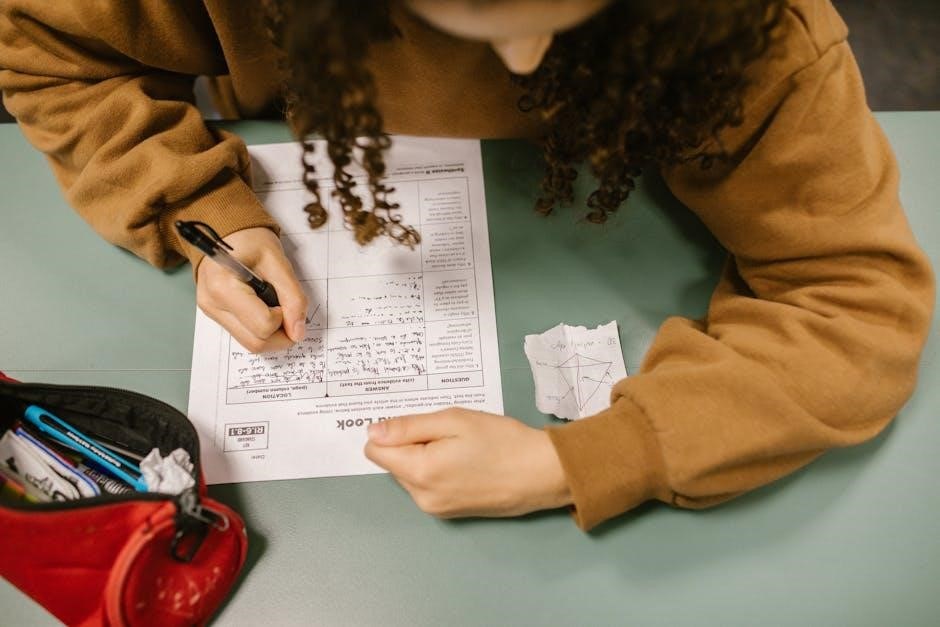Calorimetry POGIL: Understanding Heat Transfer
Calorimetry, the science of measuring heat transfer during physical and chemical changes, is explored through POGIL activities. These activities help students understand heat energy and temperature relationships, often with answer keys provided to facilitate learning and problem-solving.
What is Calorimetry?
Calorimetry is an experimental technique employed to measure the amount of heat exchanged during a chemical or physical process. It involves using a calorimeter, an insulated container, to quantify heat transfer by measuring the temperature change of a known mass of substance, typically water. The underlying principle is the conservation of energy, where the heat lost or gained by the reaction equals the heat gained or lost by the surrounding calorimeter components.
Calorimetry is crucial for determining thermodynamic properties like enthalpy changes, specific heat capacities, and understanding energy flow in reactions. POGIL activities often explore these concepts.
Key Concepts in Calorimetry
Calorimetry relies on understanding specific heat capacity, heat transfer equations, and the principles of energy conservation. These concepts allow for accurate measurement and calculation of heat changes during chemical and physical processes, often explored via POGIL activities;
Specific Heat Capacity
Specific heat capacity is a crucial concept in calorimetry, representing the amount of heat required to raise the temperature of one gram of a substance by one degree Celsius. Different materials have varying specific heat capacities, influencing how they absorb or release heat. Water, for example, has a relatively high specific heat capacity, making it useful in calorimetry experiments. Understanding specific heat allows calculation of heat transfer using equations like q = mcΔT, where ‘q’ is heat, ‘m’ is mass, ‘c’ is specific heat capacity, and ‘ΔT’ is the temperature change. POGIL activities often explore this concept.
Heat Transfer Equations
Heat transfer equations are fundamental tools in calorimetry for quantifying the energy exchanged during processes. The primary equation, q = mcΔT, relates heat (q) to mass (m), specific heat capacity (c), and temperature change (ΔT). This equation helps determine the amount of heat absorbed or released by a substance. For reactions occurring in a calorimeter, the heat lost by the reaction equals the heat gained by the surrounding water (or vice versa), expressed as q_reaction = -q_water. POGIL activities often involve applying these equations to solve problems, enhancing understanding of energy conservation and heat measurement. Understanding these equations is key to mastering calorimetry.

Calorimetry POGIL Activities
Calorimetry POGIL activities explore heat transfer principles through guided inquiry. These activities often focus on relationships between heat, temperature, and mass, encouraging students to apply calorimetry equations and deepen their understanding of energy changes.
Exploring Heat and Temperature Relationship
Calorimetry POGIL activities often begin by exploring the fundamental relationship between heat and temperature. Students investigate how energy input affects temperature changes in different substances. Through guided questions and model analysis, they learn that temperature change depends on the substance’s properties and the amount of heat added. Experiments involving heating water in saucepans versus stockpots help visualize this concept. These activities emphasize the importance of mass and specific heat capacity in determining temperature changes. Answer keys provide verification and support for understanding these initial concepts, building a foundation for more complex calorimetry calculations.
Determining Specific Heat
Calorimetry POGIL activities often involve determining the specific heat of various substances. These activities typically use experimental data collected from calorimetry experiments. Students analyze the relationship between heat transferred, mass, and temperature change to calculate specific heat. Model 2 in some POGILs focuses on this relationship, guiding students to understand the mathematical proportionality. By comparing different materials, students learn that each substance has a unique specific heat value. Answer keys help students verify their calculations and reinforce their understanding of the specific heat concept and its role in calorimetry problems.
Calorimetry Problems and Solutions
Calorimetry problems involve calculating heat transfer using equations and experimental data. Example problems often include determining heat absorbed or released during reactions, with detailed solutions provided for learning and self-assessment using a calorimetry pogil answer key.
Example Problems with Answers
Calorimetry problems often involve calculating the heat absorbed or released during chemical reactions or physical changes. A common example involves finding the specific heat of a metal by immersing it in water and measuring the temperature change. Another problem could involve determining the enthalpy change of a reaction using calorimetry data. These problems typically require using equations like q = mcΔT, where q is heat, m is mass, c is specific heat, and ΔT is the temperature change. Answers to these problems are essential for students to check their understanding and problem-solving skills, often found in Calorimetry POGIL answer keys.

Applications of Calorimetry
Calorimetry is used to determine enthalpy changes in reactions, analyze food calorie content, and measure heat capacities of substances. It’s a vital tool in chemistry, materials science, and engineering, providing crucial data.
Determining Enthalpy Changes
Calorimetry plays a crucial role in determining enthalpy changes (ΔH) for chemical reactions, helping us understand if reactions are endothermic or exothermic. By measuring the heat absorbed or released at constant pressure, calorimetry allows scientists to quantify energy changes during reactions. This involves using calorimeters, insulated devices that measure heat flow.
Analyzing temperature changes in the calorimeter, along with heat capacity and mass, allows for calculation of heat (q). Applying the relationship ΔH ≈ qp, the enthalpy change can be found. This is useful in fields like chemical engineering and materials science. POGIL activities often include problems and answer keys to help students understand these processes.

Calorimetry Experiments
Calorimetry experiments involve measuring heat transfer using calorimeters. These experiments often determine specific heat capacities or enthalpy changes. Lab setups typically include a calorimeter, thermometer, and reactants. Procedures require careful measurements and data analysis.
Lab Setup and Procedure
A typical calorimetry lab setup involves an insulated container, like a Styrofoam cup, acting as the calorimeter. A thermometer is used to measure temperature changes accurately. Reactants are carefully measured and mixed inside the calorimeter. The initial and final temperatures are recorded to determine the heat transfer.
The procedure begins with calibrating the calorimeter, if necessary. The calorimeter is filled with a known amount of water, and the initial temperature is recorded. The reaction is initiated, and the temperature change is monitored until it stabilizes. Data collected is then used to calculate heat transfer, employing equations discussed in POGIL activities, often referencing answer keys for verification.

Calorimetry POGIL Answer Key Resources
Finding reliable calorimetry POGIL answer key resources is crucial for students. These resources aid in verifying understanding and problem-solving accuracy, ensuring proper comprehension of heat transfer principles and calculations.
Finding Reliable Solutions
When seeking calorimetry POGIL answer keys, students should prioritize reliable and verified sources to ensure accuracy. Official educational websites, textbook supplements, and teacher-provided materials are generally trustworthy. It’s important to verify the solutions against multiple sources if possible, and understand the reasoning behind each answer, rather than just copying it.
Consulting with teachers or classmates can also provide clarification and deeper understanding. Be wary of unverified online forums or unofficial websites that may contain errors. Remember the goal is to learn the concepts, not just find the answers, so make sure that you are doing the work!
